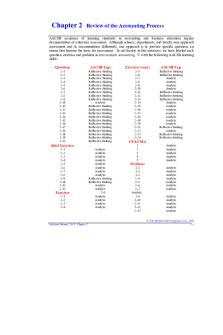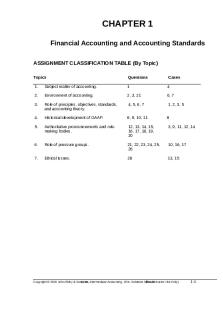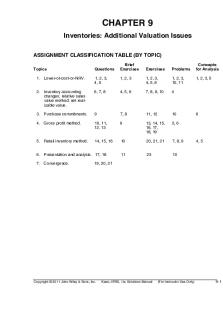Solution manual for Intermediate Accounting 7th edition by J David Spiceland PDF

| Title | Solution manual for Intermediate Accounting 7th edition by J David Spiceland |
|---|---|
| Course | Intermediate Accounting 1 |
| Institution | Pontifical and Royal University of Santo Tomas, The Catholic University of the Philippines |
| Pages | 98 |
| File Size | 1.7 MB |
| File Type | |
| Total Downloads | 14 |
| Total Views | 156 |
Summary
Download Solution manual for Intermediate Accounting 7th edition by J David Spiceland PDF
Description
Chapter 2
Review of the Accounting Process
AACSB assurance of learning standards in accounting and business education require documentation of outcomes assessment. Although schools, departments, and faculty may approach assessment and its documentation differently, one approach is to provide specific questions on exams that become the basis for assessment. To aid faculty in this endeavor, we have labeled each question, exercise and problem in Intermediate Accounting, 7e with the following AACSB learning skills: Questions
AACSB Tags
Exercises (cont.)
AACSB Tags
2–1 2–2 2–3 2–4 2–5 2–6 2–7 2–8 2–9 2–10 2–11 2–12 2–13 2–14 2–15 2–16 2–17 2–18 2–19 2–20 2–21
Reflective thinking Reflective thinking Reflective thinking Reflective thinking Reflective thinking Reflective thinking Reflective thinking Reflective thinking Reflective thinking Analytic Reflective thinking Reflective thinking Reflective thinking Reflective thinking Reflective thinking Reflective thinking Reflective thinking Reflective thinking Reflective thinking Reflective thinking Reflective thinking
2–5 2–6 2–7 2–8 2–9 2–10 2–11 2–12 2–13 2–14 2–15 2–16 2–17 2–18 2–19 2–20 2–21 2–22 2–23 2–24
Reflective thinking Reflective thinking Analytic Analytic Analytic Analytic Reflective thinking Reflective thinking Reflective thinking Analytic Analytic Analytic Analytic Analytic Analytic Analytic Reflective thinking Analytic Reflective thinking Reflective thinking
Brief Exercises 2–1 2–2 2–3 2–4 2–5 2–6 2–7 2–8 2–9 2–10 2–11 2–12
Exercises 2–1 2–2 2–3 2–4
Solutions Manual, Vol.1, Chapter 2
Analytic Analytic Analytic Analytic Analytic Analytic Analytic Analytic Reflective thinking Reflective thinking Analytic Analytic 2–8 Analytic Analytic Analytic Analytic
CPA/CMA 1 2 3 4 5
Analytic Analytic Analytic Analytic Analytic
Problems 2–1 2–2 2–3 2–4 2–5 2–6 2–7 Analytic 2–9 2–10 2–11 2–12 2–13
Analytic Analytic Analytic Analytic Analytic Analytic Analytic Analytic Analytic Analytic Analytic Analytic
© The McGraw-Hill Companies, Inc., 2013 2–1
QUESTIONS FOR REVIEW OF KEY TOPICS Question 2–1 External events involve an exchange transaction between the company and a separate economic entity. For every external transaction, the company is receiving something in exchange for something else. Internal events do not involve an exchange transaction but do affect the financial position of the company. Examples of external events are the purchase of inventory, a sale to a customer, and the borrowing of cash from a bank. Examples of internal events include the recording of depreciation expense, the expiration of prepaid rent, and the accrual of salary expense.
Question 2–2 According to the accounting equation, there is equality between the total economic resources of an entity, its assets, and the claims to those resources, liabilities, and equity. This implies that, since resources must always equal claims, the net effect of any transaction cannot affect one side of the accounting equation differently than the other side.
Question 2–3 The purpose of a journal is to capture, in chronological order, the dual effect of a transaction. A general ledger is a collection of storage areas called accounts. These accounts keep track of the increases and decreases in each element of financial position.
Question 2–4 Permanent accounts represent the financial position of a company—assets, liabilities and owners' equity—at a particular point in time. Temporary accounts represent the changes in shareholders’ equity, the retained earnings component of equity for a corporation, caused by revenue, expense, gain, and loss transactions. It would be cumbersome to record revenue/expense, gain/loss transactions directly into the permanent retained earnings account. Recording these transactions in temporary accounts facilitates the preparation of the financial statements.
Question 2–5 Assets are increased by debits and decreased by credits. Liabilities and equity accounts are increased by credits and decreased by debits.
Question 2–6 Revenues and gains are increased by credits and decreased by debits. Expenses and losses are increased by debits (thus causing owners’ equity to decrease) and decreased by credits (thus causing owners’ equity to increase).
Answers to Questions (continued) © The McGraw-Hill Companies, Inc., 2013 2–2
Intermediate Accounting, 7/e
Question 2–7 The first step in the processing cycle is to identify external transactions affecting the accounting equation. Source documents, such as sales invoices, bills from suppliers, and cash register tapes, help to identify the transactions and then provide the information necessary to process the transaction.
Question 2–8 Transaction analysis is the process of reviewing the source documents to determine the dual effect on the accounting equation and the specific elements involved.
Question 2–9 After transactions are recorded in a journal, the debits and credits must be transferred to the appropriate general ledger accounts. This transfer is called posting.
Question 2–10 Transaction 1 records the purchase of $20,000 of inventory on account. Transaction 2 records a credit sale of $30,000 and the corresponding cost of goods sold of $18,000.
Question 2–11 An unadjusted trial balance is a list of the general ledger accounts and their balances at a time before any end-of-period adjusting entries have been recorded. An adjusted trial balance is prepared after adjusting entries have been recorded and posted to the accounts.
Solutions Manual, Vol.1, Chapter 2
© The McGraw-Hill Companies, Inc., 2013 2–3
Answers to Questions (continued) Question 2–12 Adjusting entries record the effect on financial position of internal events, those that do not involve an exchange transaction with another entity. They must be recorded at the end of any period when financial statements are prepared to properly reflect financial position and results of operations according to the accrual accounting model.
Question 2–13 Closing entries transfer the balances in the temporary owners’ equity accounts to a permanent owners’ equity account, retained earnings for a corporation. This is done only at the end of a fiscal year in order to reduce the temporary accounts to zero before beginning the next reporting year.
Question 2–14 Prepaid expenses represent assets recorded when a cash disbursement creates benefits beyond the current reporting period. Examples are supplies on hand at the end of a period, prepaid rent, and the cost of plant and equipment.
Question 2–15 The adjusting entry required when unearned revenues are earned is a debit to the unearned revenue liability and a credit to revenue.
Question 2–16 Accrued liabilities are recorded when an expense has been incurred that will not be paid until a subsequent reporting period. The adjusting entry required to record an accrued liability is a debit to an expense and a credit to a liability.
© The McGraw-Hill Companies, Inc., 2013 2–4
Intermediate Accounting, 7/e
Answers to Questions (continued) Question 2–17 Income statement—The purpose of the income statement is to summarize the profit-generating activities of the company during a particular period of time. It is a change statement that is reporting the changes in owners’ equity that occurred during the period as a result of revenues, expenses, gains, and losses. Statement of comprehensive income—The purpose of the statement of comprehensive income is to report the changes in shareholders’ equity during the reporting period that were not a result of transactions with owners. This statement includes net income and also other comprehensive income items. Balance sheet—The purpose of the balance sheet is to present the financial position of the company at a particular point in time. It is an organized array of assets, liabilities, and permanent owners’ equity accounts. Statement of cash flows—The purpose of the statement of cash flows is to disclose the events that caused cash to change during the period. Statement of shareholders’ equity—The purpose of the statement of shareholders’ equity is to disclose the sources of the changes in the various permanent shareholders’ equity accounts that occurred during the period. This statement includes changes resulting from investments by owners, distributions to owners, net income, and other comprehensive income.
Question 2–18 A worksheet provides a means of organizing the accounting information needed to prepare adjusting and closing entries and the financial statements. This error would result in an overstatement of revenue and thus net income and retained earnings, and an understatement of liabilities.
Question 2–19 Reversing entries are recorded at the beginning of a reporting period. They remove the effects of some of the adjusting entries made at the end of the previous reporting period. This simplifies the journal entries made during the new period by allowing cash payments or cash receipts to be entered directly into the expense or revenue account without regard to the accrual made at the end of the previous period.
Question 2–20 The purpose of special journals is to record, in chronological order, the dual effect of repetitive types of transactions, such as cash receipts, cash disbursements, credit sales, and credit purchases. Special journals simplify the recording process in the following ways: (1) journalizing the effects of a particular transaction is made more efficient through the use of specifically designed formats; (2) individual transactions are not posted to the general ledger accounts, but are accumulated in the special journals and a summary posting is made on a periodic basis; and (3) the responsibility for recording journal entries for the repetitive types of transactions is placed on individuals who have specialized training in handling them.
Solutions Manual, Vol.1, Chapter 2
© The McGraw-Hill Companies, Inc., 2013 2–5
Answers to Questions (concluded) Question 2–21 The general ledger is a collection of control accounts representing assets, liabilities, permanent and temporary shareholders’ equity accounts. The subsidiary ledger contains a group of subsidiary accounts associated with a particular general ledger control account. For example, there will be a subsidiary ledger for accounts receivable that will keep track of the increases and decreases in the account receivable balance for each of the company’s customers purchasing goods or services on credit. At any point in time, the balance in the accounts receivable control account should equal the sum of the balances in the accounts receivable subsidiary ledger accounts.
© The McGraw-Hill Companies, Inc., 2013 2–6
Intermediate Accounting, 7/e
BRIEF EXERCISES Brief Exercise 2–1 Assets 1. + 165,000 2. – 40,000 3. + 200,000 – 120,000 4. + 180,000 – 180,000 5. – 145,000
=
Liabilities + Paid-in Capital + Retained Earnings
(inventory) + 165,000 (accounts payable) (cash) (accounts receivable) (inventory) (cash) (accounts receivable) (cash) – 145,000 (accounts payable)
– 40,000 (expense) + 200,000 (revenue) – 120,000 (expense)
Brief Exercise 2–2 1. 2. 3.
4. 5.
Inventory .................................................................. Accounts payable ................................................. Salaries expense ....................................................... Cash ..................................................................... Accounts receivable ................................................. Sales revenue ........................................................ Cost of goods sold .................................................... Inventory .............................................................. Cash ......................................................................... Accounts receivable ............................................ Accounts payable .................................................... Cash ......................................................................
Solutions Manual, Vol.1, Chapter 2
165,000 165,000 40,000 40,000 200,000 200,000 120,000 120,000 180,000 180,000 145,000 145,000
© The McGraw-Hill Companies, Inc., 2013 2–7
Brief Exercise 2–3 BALANCE SHEET ACCOUNTS Cash Accounts receivable ___________________________ ___________________________ 6/1 Bal. 4.
6/30 Bal.
65,000 180,000
40,000 145,000 _______________
2. 5.
60,000
6/30 Bal.
0 165,000 120,000 _______________
3.
45,000
43,000 200,000
180,000
4.
______________ 6/30 Bal.
Inventory ___________________________ 6/1 Bal. 1.
6/1 Bal. 3.
63,000
Accounts payable ___________________________ 6/1 Bal. 5.
22,000 145,000 165,000 ______________
1.
42,000
6/30 Bal.
INCOME STATEMENT ACCOUNTS Sales revenue ___________________________
Cost of goods sold ___________________________
0 , 200 000 _______________
6/1 Bal. 3.
6/1 Bal. 3.
0 , 120 000 ______________
200,000
6/30 Bal.
6/30 Bal. 120,000
Salaries expense ___________________________ 6/1 Bal. 2.
0 40,000 _______________
6/30 Bal.
40,000
© The McGraw-Hill Companies, Inc., 2013 2–8
Intermediate Accounting, 7/e
Brief Exercise 2–4 1. 2. 3.
Prepaid insurance ..................................................... Cash ..................................................................... Note receivable ........................................................ Cash ..................................................................... Equipment ................................................................ Cash .....................................................................
12,000 12,000 10,000 10,000 60,000 60,000
Brief Exercise 2–5 1. 2. 3.
Insurance expense ($12,000 x 3/12) ............................. Prepaid insurance ................................................ Interest receivable ($10,000 x 6% x 6/12) ..................... Interest revenue .................................................... Depreciation expense ............................................... Accumulated depreciation – equipment ...............
3,000 3,000 300 300 12,000 12,000
Brief Exercise 2–6 Net income would be higher by $14,700 ($3,000 –300 + 12,000).
Solutions Manual, Vol.1, Chapter 2
© The McGraw-Hill Companies, Inc., 2013 2–9
Brief Exercise 2–7 1. 2. 3. 4.
Service revenue ....................................................... Unearned service revenue ................................... Advertising expense ($2,000 x 1/2) ............................. Prepaid advertising ............................................. Salaries expense ....................................................... Salaries payable ................................................... Interest expense ($60,000 x 8% x 4/12) ........................ Interest payable ....................................................
4,000 4,000 1,000 1,000 16,000 16,000 1,600 1,600
Brief Exercise 2–8 Assets would be higher by $1,000, the amount of prepaid advertising that expired during the month. Liabilities would be lower by $21,600 ($4,000 + 16,000 + 1,600). Shareholders’ equity (and net income for the period) would be higher by $22,600.
Brief Exercise 2–9 BOWLER CORPORATION Income Statement For the Year Ended December 31, 2013 Sales revenue ............................................... Cost of goods sold ....................................... Gross profit .................................................. Operating expenses: Salaries ...................................................... Rent ........................................................... Depreciation .............................................. Miscellaneous ........................................... Total operating expenses .............. Net income ..................................................
© The McGraw-Hill Companies, Inc., 2013 2–10
$325,000 168,000 157,000
$45,000 20,000 30,000 12,000 107,000 $ 50,000
Intermediate Accounting, 7/e
Brief Exercise 2–10 BOWLER CORPORATION Balance Sheet At December 31, 2013 Assets Current assets: Cash ........................................................... Accounts receivable .................................. Inventory ................................................... Total current assets .............................. Property and equipment: Machinery and Equipment ........................ Less: Accumulated depreciation ............... Total assets ........................................
$ 5,000 10,000 16,000 31,000
100,000 (40,000)
60,000 $91,000
Liabilities and Shareholders' Equity Current liabilities: Accounts payable ...................................... Salaries payable ......................................... Total current liabilities ......................... Shareholders’ equity: Common stock .......................................... Retained earnings ...................................... Total shareholders’ equity ................... Total liabilities and shareholders’ equity
Solutions Manual, Vol.1, Chapter 2
$ 20,000 12,000 32,000
$50,000 9,000 59,000 $91,000
© The McGraw-Hill Companies, Inc., 2013 2–11
Brief Exercise 2–11 Sales revenue ................................................................... 850,000 Income summary ......................................................... 850,000 Income summary ............................................................. 815,000 Cost of goods sold ....................................................... 580,000 Salaries expense .......................................................... 180,000 Rent expense ............................................................... 40,000 Interest expense ........................................................... 15,000 Income summary ($850,000 – 815,000) .............................. Retained earnings .......................................................
35,000 35,000
Brief Exercise 2–12 Revenues Expenses: Salaries Utilities Advertising Net Income
$428,000* (240,000) (33,000)** (12,000) $143,000
*$420,000 cash received plus $8,000 increase ($60,000 – 52,000) in amount due from customers: Cash ........................................................................ 420,000 Accounts receivable (increase in account) .............. 8,000 Sales revenue (to balance) ................................... 428,000 ** $35,000 cash paid less $2,000 decrease in amount owed to utility company: Utilities expense (to balance) .................................. Utilities expense payable (decrease in account) ...... Cash .....................................................................
© The McGraw-Hill Companies, Inc., 2013 2–12
33,000 2,000 35,000
Intermediate Accounting, 7/e
EXERCISES Exercise 2–1 Assets 1. + 300,000 2. – 10,000 + 40,000 3. + 90,000 4. + 120,000 – 70,000 5. – 5,000 6. – 6,000 + 6,000 7. – 70,000 8. + 55,000 – 55,000 9. – 1,0...
Similar Free PDFs

INtermediate spiceland solution Ch 4
- 86 Pages
Popular Institutions
- Tinajero National High School - Annex
- Politeknik Caltex Riau
- Yokohama City University
- SGT University
- University of Al-Qadisiyah
- Divine Word College of Vigan
- Techniek College Rotterdam
- Universidade de Santiago
- Universiti Teknologi MARA Cawangan Johor Kampus Pasir Gudang
- Poltekkes Kemenkes Yogyakarta
- Baguio City National High School
- Colegio san marcos
- preparatoria uno
- Centro de Bachillerato Tecnológico Industrial y de Servicios No. 107
- Dalian Maritime University
- Quang Trung Secondary School
- Colegio Tecnológico en Informática
- Corporación Regional de Educación Superior
- Grupo CEDVA
- Dar Al Uloom University
- Centro de Estudios Preuniversitarios de la Universidad Nacional de Ingeniería
- 上智大学
- Aakash International School, Nuna Majara
- San Felipe Neri Catholic School
- Kang Chiao International School - New Taipei City
- Misamis Occidental National High School
- Institución Educativa Escuela Normal Juan Ladrilleros
- Kolehiyo ng Pantukan
- Batanes State College
- Instituto Continental
- Sekolah Menengah Kejuruan Kesehatan Kaltara (Tarakan)
- Colegio de La Inmaculada Concepcion - Cebu














